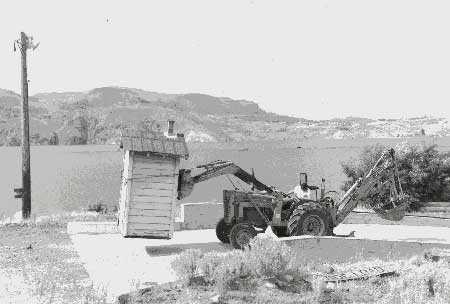|
Lake Roosevelt
Administrative History |

|
CHAPTER 7:
Building and Maintaining the Park: Administrative and Visitor Facilities (continued)
Sewage Disposal and Electric
Lines
In 1943, when Park Service personnel were preparing the layouts for various recreation sites along Lake Roosevelt, the Regional Engineer commented that sewage disposal was probably the greatest technical problem the Park Service would face. He recommended locating comfort stations high enough so that the necessary drop in elevation to disposal fields could be provided. The initial sewage facilities at LARO were septic tanks/leach fields for buildings and pit toilets. [28]
A good example of LARO's creative re-use of surplus materials was the conversion of short-term air-base runway landing mats into liners for outhouse pits. Maintenance workers stored "tons and tons" of these 14-inch-wide interlocking mats at the yard at headquarters, according to former LARO employee Don Everts. They welded them together to form boxes. The mats were pierced with holes that were "about the size of a coffee cup. There was enough to keep the solids in and the fluids would run out." Everts noted, "It made a real good pit. . . . .You just dropped them in the hole with a backhoe and backfilled it and there you had it." Unlike wooden pit liners, which rotted quickly, these steel liners lasted virtually forever. The recycled mats worked well in LARO's many outhouse pits until the Mission 66 program called for the replacement of pit privies with vault toilets. [29]
As visitation to LARO increased in the 1970s and 1980s, so did problems associated with sanitation. Assistant Superintendent Kelly Cash quipped in 1989, "People are camping on beaches. Human waste is a problem. On some of the beaches, it looks like a Kleenex factory has exploded." [30] By the 1980s, most of LARO's pit toilets had been replaced with vault toilets, and several comfort stations had running water.
Campers on beaches without sewage disposal facilities are required to bring portable toilets with them. Today, sewage is not a significant problem at LARO. [31]
In the early 1970s, LARO used Regional Reserve funding to convert some of its overhead power lines in developed sites to underground, in accordance with Park Service policy on utilities for recreation areas. This costly project to improve the appearance of the sites was mostly done by contractors. LARO's 1990 Special Park Use Management Plan required all existing electric lines to be underground within the NRA. This raised concerns with local electrical utilities. All or almost all the lines are now underground within the recreational area boundaries. [32]
Trash and Hazardous Materials Disposal
Trash disposal by visitors, both on water and on land, was another important concern at LARO in the early years. The general practice in the 1950s was to put garbage in a sack and toss it into the deep waters of Lake Roosevelt (LARO Superintendent Greider recommended taking the trash ashore and burying it). By 1963, LARO employees were collecting some 26.5 tons of garbage per week from the various campgrounds. Trash was disposed of by burning in incinerators or disposal in landfills. Some campgrounds had sunken-barrel trash containers in which the garbage was periodically burned. In 1976, a Park Service directive instructed all units to attempt to have all solid waste disposed of outside the park by private contractors, giving preference to sanitary landfills over incineration. LARO's maintenance personnel then began collecting the trash and hauling it to landfills in Coulee Dam, Davenport, and Kettle Falls in plastic bags. [33]

| |
| Installation of privy at Tiffany campground, 1961. This was one of many privies that were constructed out of prefabricated panels by crews living and working on a Reclamation barge that traveled from one campground to another. Photo courtesy of National Park Service, Lake Roosevelt National Recreation Area (LARO.HQ.MENG). | |
LARO began annual park-wide hazardous waste surveys in 1987 in response to increased state and federal regulations and awareness of the human health hazards associated with toxic wastes. In cooperation with Reclamation, LARO maintenance personnel developed procedures for identifying and disposing of hazardous substances and containers, based on national guidelines. Hazardous wastes hauled away as part of LARO's ongoing safety program include unused pesticides, lead-based paints, and automotive shop oils and solvents. The 1997 Resource Management Plan acknowledged that LARO needed to identify hazardous materials used in the park, clean up hazardous waste sites, and train Park Service and concession employees on the issues. LARO staff is currently preparing a Hazardous Materials Management plan. [34]
Gasoline and chemicals are shipped by railroad, trucks, and ferries around and through the NRA. Park Service staff responds to accidental spills of hazardous and/or toxic substances from commercial or private sources throughout the Lake Roosevelt area. The park developed an Oil and Hazardous Substance Spill Plan in 1989. The park has spill containment supplies that are available at various sites. In the 1990s, park staff worked with the Lake Roosevelt Forum's emergency services committee to develop a regional spill response plan. [35]
LARO's underground storage tanks became an issue in the late 1980s because of new Environmental Protection Agency standards. The park began phasing out its gasoline operations in many areas of the park and instead provided vehicles, boats, and equipment with credit cards for use at service stations. The park prepared a Storage Tank Management Plan in 1991 for the nineteen regulated tanks used by park and concession staff and for the four unregulated tanks at Park Service headquarters. By 1993, LARO had only three underground storage tanks. [36]
| <<< Previous | <<< Contents >>> | Next >>> |
laro/adhi/adhi7c.htm
Last Updated: 22-Apr-2003